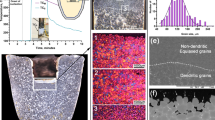Abstract
Metallography reveals the correlations between the amount, size, and morphology of ultrafine particles in welding materials (flux-cored and composite wires, coated electrodes, and agglomerated fluxes), as well as the processes of formation of exogenous crystallization centers in the welding pool that facilitate the structure modification and promotion of processing and working properties of deposited metal. The phenomenological model of the nucleation on ultrafine exogenous refractory chemical clusters is developed on the basis of the experimental data and on the existing view of the kinetics of fast physicochemical processes in the welding fire point.
Similar content being viewed by others
References
Panin, V.E., Sergeev, V.P., Panin, A.V., and Pochivalov, Yu.I., Nanostructuring of surface layers and production of nanostructured coatings as an effective method of strengthening modern structural and tool materials, Phys. Met. Metallogr., 2007, vol. 104, no. 6, pp. 627–636.
Ryabtsev, I.A., Kondrat’ev, I.A., Gadzyra, N.F., et al., Influence of ultrafine carbides in the flux-cored wire on the properties of heat-resistant welded metal, Avtom. Svarka, 2009, no. 6, pp. 13–16.
Sokolov, G.N., Lysak, V.I., Troshkov, A.S., et al., Modifying of weld metal by nanosized tungsten carbides, Fiz. Khim. Obrab. Mater., 2009, no. 6, pp. 41–47.
Eremin, E.N., The use of nanoparticles of refractory compounds to improve the quality of welded joints of superalloys, Omsk. Nauch. Vestn., 2009, no. 3, pp. 63–67.
Golovin, E.D., Bataev, A.A., Cherepanov, A.N., and Bolotova, L.K., Application of nanopowders of refractory compounds in the laser welding of carbon steels, Ross. Nanotekhnol., 2009, vol. 2, nos. 3–4, pp. 35–57.
Hou, Q.V., Huang, Z., and Wang, J.N., Influence of nano-Al2O3 particles on the microstructure and wear resistance of the nickel-based alloy coating deposited by plasma transferred arc overlay welding, Surf. Coat. Technol., 2011, vol. 206, nos. 8–9, pp. 2806–2812.
Artemyev, A.A., Sokolov, G.N., and Lysak, V.I., Effect of microparticles of titanium diboride and nanoparticles of titanium carbonitride on the structure and properties of deposited metal, Met. Sci. Heat Treat., 2012, vol. 53, no. 11, pp. 603–607.
Smirnov, A.N., Knyaz’kov, V.L., Radchenko, M.V., et al., Influence of nano-dispersed particles of Al2O3 on the structural-phase state of coating systems Ni–Cr–B–Si/WC obtained by plasma-powder surfacing, Svarka Diagn., 2012, no. 5, pp. 32–37.
Kobernik, N.V., Chernyshov, G.G., Gvozdev, P.P., et al., Antifriction properties of the coatings obtained by plasma welding of babbitt with carbon nanotubes, Svarka Diagn., 2013, no. 3, pp. 27–31.
Sokolov, G.N., Zorin, I.V., Artem’ev, A.A., Litvinenko-Ar’kov, V.B., Dubtsov, Yu.N., Lysak, V.I., Kharlamov, V.O., Samokhin, A.V., and Tsvetkov, Yu.V., Structure formation and properties of weld alloys with addition of refractory compound nanoparticles, Inorg. Mater.: Appl. Res., 2015, vol. 6, no. 3, pp. 240–248.
Zhilyaev, V.A., Fedorenko, V.V., and Shveikin, G.P., The mechanism of forming of the coaxial structure in alloys based on carbide and titanium carbide, Tr. V mezhd. konf. po poroshkovoi metallurgii v Chekhoslovatskoi Sotsialisticheksoi Respublike (Proc. V Int. Conf. on Powder Metallurgy in Czechoslovakia Social Republic), Gottwaldov, 1978, vol. 2, pp. 189–200.
Mal’tsev, M.V., Modifitsirovanie struktury metallov i splavov (Modification of the Structure of Metals and Alloys), Moscow: Metallurgiya, 1964.
Rebinder, P.A., Izbrannye trudy. Kniga 2. Poverkhnostnye yavleniya v dispersnykh sistemakh. Fiziko-khimicheskaya mekhanika (Selected Research Works, Book 2: Surface Processes in Dispersed Systems. Physical-Chemical Mechanics), Moscow: Nauka, 1979.
Saburov, V.P., Eremin, E.N., Cherepanov, A.N., et al., Modifitsirovanie stalei i splavov dispersnymi inokulyatami (Modification of Steels and Alloys by Dispersed Inoculators), Omsk: Omsk. Gos. Tekh. Univ., 2002.
Sokolov, G.N., Lysak, V.I., Zorin, I.V., Artem’ev, A.A., Dubtsov, Yu.N., and Troshkov, A.S., Effect of ultrafine components on welded joint metal properties for metal structure operation at negative temperatures, Chem. Petrol. Eng., 2015, vol. 51, no. 3, pp. 286–290.
Erokhin, A.A., Osnovy svarki plavleniem. Fiziko-khimicheskie zakonomernosti (Fundamentals of Fusion Welding: Physical-Chemical Principles), Moscow: Mashinostroenie, 1973.
Grigorov, I.G. and Zainulin, Yu.G., Dependence of melting temperature of nanodispersed titanium carbonitride from particle radius, Perspekt. Mater., 2007, no. 6, pp. 60–63.
Zhukhovitskii, A.A., Belashchenko, D.K., and Bekshtein, B.S., Fiziko-khimicheskie osnovy metallurgicheskikh protsessov (Physical-Chemical Principles of Metallurgical Processes), Moscow: Metallurgiya, 1973.
Woods, R. and Milner, D., Motion in the weld pool in arc welding, Weld. J., 1971, no. 4, pp. 163–173.
Erygin, V.I., Analysis of melt movement rate in the rear of the bath during welding by consumable electrode, Svarochnoe Proizvod., 1980, no. 3, pp. 3–5.
Stolbov, V.I., Svarochnaya vanna: monografiya (Welding Bath: Monograph), Tolyatti: Toliat. Gos. Univ., 2007.
Shneerson, V.Ya., The formation of the layered structure of the weld metal during welding fusion, Svarka Diagn., 2013, no. 4, pp. 16–23.
Author information
Authors and Affiliations
Corresponding author
Additional information
Original Russian Text © G.N. Sokolov, V.I. Lysak, I.V. Zorin, A.A. Artemyev, Yu.N. Dubtsov, V.O. Kharlamov, A.A. Antonov, 2015, published in Voprosy Materialovedeniya, 2015, No. 4(84), pp. 159–168.
Rights and permissions
About this article
Cite this article
Sokolov, G.N., Lysak, V.I., Zorin, I.V. et al. Phenomenological model of crystallization center nucleation in metal melt during welding under the influence of ultrafine refractory components. Inorg. Mater. Appl. Res. 7, 884–891 (2016). https://doi.org/10.1134/S2075113316060204
Received:
Published:
Issue Date:
DOI: https://doi.org/10.1134/S2075113316060204




